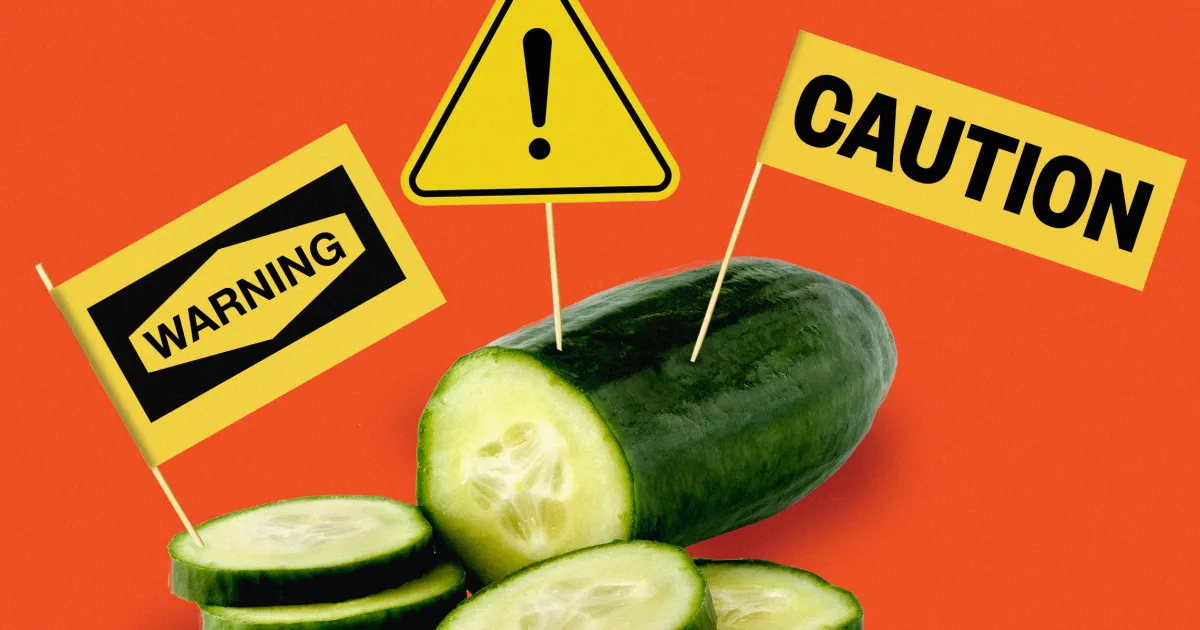
Last spring and summer, a significant salmonella outbreak swept across the United States, impacting over 550 individuals and necessitating hospitalization for 155 of them. Surprisingly, the source of this outbreak was not the typical culprits such as raw eggs or undercooked chicken, but rather a common salad ingredient: cucumbers. Fast forward to today, and cucumbers are once again causing illness, with federal officials identifying a Florida farm as the likely source.
In a recent incident, 45 individuals across 18 states reported salmonella infections linked to cucumbers from Bedner Growers, located in Palm Beach County, Florida. This outbreak has triggered a widespread recall affecting various products, including California rolls at Target and banh mi sandwiches at a high school in North Carolina. The Food and Drug Administration (FDA) is currently investigating how these cucumbers became contaminated, as the details remain unclear. However, last year, the FDA found that Bedner Growers had used untreated canal water for irrigation, which was contaminated with a strain of salmonella responsible for the previous illnesses.
While it may be surprising, cucumbers and other fresh produce can be sources of salmonella, leading to symptoms such as diarrhea, stomach cramps, and fever. In severe cases, these infections can become life-threatening. Cooking can effectively kill the bacteria; however, raw fruits and vegetables, including cucumbers, pose a risk once contaminated. This underlines the importance of safeguarding fresh produce from pathogens that may reside in irrigation or washing water.
Many individuals, like Tara Chaffin from Midland, Michigan, are shocked to learn that healthy foods like cucumbers can lead to serious illness. Chaffin, who contracted salmonella during last year’s outbreak, expressed disbelief, stating, “I wouldn’t expect a fruit or a vegetable to get me sick.” Her experience highlights the unexpected risks associated with consuming fresh produce.
This year's cucumber-related outbreak was detected in April during a follow-up inspection of Bedner Growers, where salmonella strains matched those from recent patients. Epidemiologist Craig Hedberg from the University of Minnesota noted the disturbing trend of repeated contamination from the same grower, emphasizing the need for improved water management practices. Bedner Growers, which has previously defended its irrigation practices, has not provided a comment regarding the latest outbreak.
The consecutive recalls from the same farm underscore the critical issue of water contamination, a significant challenge in ensuring the safety of fresh produce. A new FDA rule mandating farmers to conduct water safety assessments has recently come into effect for larger farms, though some industry groups express concern that budget cuts to food safety programs may hinder effective education and outreach regarding these new regulations.
Food safety advocates argue that current requirements do not go far enough, as farmers have the discretion to manage any hazards identified. Anne Schechinger from the Environmental Working Group pointed out that the regulations essentially allow farmers to self-regulate. The FDA claims that the new water rule will enhance public health, while the International Fresh Produce Association asserts that most growers are already managing water risks effectively.
Fresh Start Produce Sales, the distributor of cucumbers tied to the salmonella outbreaks, announced its decision to cease purchasing from Bedner Growers, stating that they require suppliers to adhere strictly to U.S. food safety standards.
Chaffin’s personal battle with salmonella led to severe symptoms, including chills, diarrhea, and a high fever. After multiple tests ruled out other illnesses, she was shocked to discover her infection stemmed from cucumbers. This revelation left her questioning the safety of fresh produce, as she recalled her recent meals.
Determining the source of contamination can take considerable time, often weeks or months. By August, the FDA linked the cucumber growers to the outbreak, revealing that they used untreated canal water contaminated with salmonella strains similar to those that caused illnesses.
Salmonella is commonly found in the digestive tracts of various animals and can contaminate fruits and vegetables through animal waste entering the water supply from wildlife, runoff from animal operations, and flooding. Jennifer McEntire, a food safety consultant, noted that water is a common vector for produce-related outbreaks. As fresh produce is often consumed raw, ensuring its safety before consumption is essential.
Bedner Growers, established in the 1960s, operates on 1,500 acres of bell peppers and 500 acres of cucumbers. The farm sells produce to major retailers and directly to customers through market stands. During last year’s outbreak, they defended their irrigation practices, claiming compliance with federal rules, despite concerns about the adequacy of existing regulations.
As calls for stricter food safety measures continue, the FDA's recent regulations require farmers to create safety plans for their water sources. While testing water for pathogens is a critical step, various factors complicate implementation, especially amid budget cuts affecting outreach and education programs. Industry representatives emphasize the need for better support to assist farmers in developing effective safety plans.
Meanwhile, Chaffin continues to struggle with lingering health issues stemming from her salmonella infection, including painful joint swelling diagnosed as reactive arthritis. Despite her ongoing challenges, she strives to maintain a positive outlook, although she remains deeply concerned about recurring outbreaks from the same source.
“Something’s got to be done,” she insists. “This is the second summer in a row — someone’s got to be held accountable.”